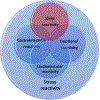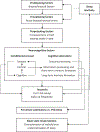The impact of stress on sleep: Pathogenic sleep reactivity as a vulnerability to insomnia and circadian disorders
- PMID: 29797753
- PMCID: PMC7045300
- DOI: 10.1111/jsr.12710
The impact of stress on sleep: Pathogenic sleep reactivity as a vulnerability to insomnia and circadian disorders
Abstract
Sleep reactivity is the trait-like degree to which stress exposure disrupts sleep, resulting in difficulty falling and staying asleep. Individuals with highly reactive sleep systems experience drastic deterioration of sleep when stressed, whereas those with low sleep reactivity proceed largely unperturbed during stress. Research shows that genetics, familial history of insomnia, female gender and environmental stress influence how the sleep system responds to stress. Further work has identified neurobiological underpinnings for sleep reactivity involving disrupted cortical networks and dysregulation in the autonomic nervous system and hypothalamic-pituitary-adrenal axis. Sleep reactivity is most pathologically and clinically pertinent when in excess, such that high sleep reactivity predicts risk for future insomnia disorder, with early evidence suggesting high sleep reactivity corresponds to severe insomnia phenotypes (sleep onset insomnia and short sleep insomnia). High sleep reactivity is also linked to risk of shift-work disorder, depression and anxiety. Importantly, stress-related worry and rumination may exploit sensitive sleep systems, thereby augmenting the pathogenicity of sleep reactivity. With the development of cost-effective assessment of sleep reactivity, we can now identify individuals at risk of future insomnia, shift-work disorder and mental illness, thus identifying a target population for preventive intervention. Given that insomniacs with high sleep reactivity tend to present with severe insomnia phenotypes, patient sleep reactivity may inform triaging to different levels of treatment. Future research on sleep reactivity is needed to clarify its neurobiology, characterize its long-term prospective associations with insomnia and shift-work disorder phenotypes, and establish its prognostic value for mental illness and other non-sleep disorders.
Keywords: Ford insomnia response to stress test; mental health; preventive treatment.
© 2018 European Sleep Research Society.
Conflict of interest statement
CONFLICT OF INTEREST
CLD has received research support from Merck & Co., Eisai Co., Aladdin Dreamer, Jazz, Actelion and Teva, and has served on speakers’ bureau for Merck & Co. DAK and JRA report no conflicts of interest.
Figures





Similar articles
-
Hyperarousal and sleep reactivity in insomnia: current insights.Nat Sci Sleep. 2018 Jul 17;10:193-201. doi: 10.2147/NSS.S138823. eCollection 2018. Nat Sci Sleep. 2018. PMID: 30046255 Free PMC article. Review.
-
Chronic insomnia is associated with nyctohemeral activation of the hypothalamic-pituitary-adrenal axis: clinical implications.J Clin Endocrinol Metab. 2001 Aug;86(8):3787-94. doi: 10.1210/jcem.86.8.7778. J Clin Endocrinol Metab. 2001. PMID: 11502812
-
Is a blunted cortisol response to stress a premorbid risk for insomnia?Psychoneuroendocrinology. 2022 Oct;144:105873. doi: 10.1016/j.psyneuen.2022.105873. Epub 2022 Jul 22. Psychoneuroendocrinology. 2022. PMID: 35905512
-
Identifying At-Risk Individuals for Insomnia Using the Ford Insomnia Response to Stress Test.Sleep. 2016 Feb 1;39(2):449-56. doi: 10.5665/sleep.5462. Sleep. 2016. PMID: 26446111 Free PMC article.
-
Sleep disturbances in generalized anxiety Disorder: The central role of insomnia.Sleep Med. 2025 Aug;132:106545. doi: 10.1016/j.sleep.2025.106545. Epub 2025 Apr 29. Sleep Med. 2025. PMID: 40318600 Review.
Cited by
-
Insomnia and cardiovascular outcomes.Sleep Sci. 2021 Jan-Mar;14(1):1-2. doi: 10.5935/1984-0063.20200109. Sleep Sci. 2021. PMID: 34104330 Free PMC article. No abstract available.
-
Associations of meeting 24-h movement guidelines with stress and self-rated health among adults: is meeting more guidelines associated with greater benefits?BMC Public Health. 2021 May 17;21(1):929. doi: 10.1186/s12889-021-10979-3. BMC Public Health. 2021. PMID: 34001090 Free PMC article.
-
Medical clowns improve sleep and shorten hospitalization duration in hospitalized children.Sci Rep. 2024 Jan 29;14(1):2357. doi: 10.1038/s41598-024-52943-2. Sci Rep. 2024. PMID: 38286867 Free PMC article.
-
Insomnia Disorder Among Coronavirus Disease Survivors: A South Korean Nationwide Cohort Study.Psychiatry Investig. 2021 Nov;18(11):1082-1090. doi: 10.30773/pi.2021.0223. Epub 2021 Oct 29. Psychiatry Investig. 2021. PMID: 34710959 Free PMC article.
-
Divergent Spatial Learning, Enhanced Neuronal Transcription, and Blood-Brain Barrier Disruption Develop During Recovery from Post-Injury Sleep Fragmentation.Neurotrauma Rep. 2023 Sep 21;4(1):613-626. doi: 10.1089/neur.2023.0018. eCollection 2023. Neurotrauma Rep. 2023. PMID: 37752925 Free PMC article.
References
-
- Åkerstedt T, Kecklund G, & Axelsson J (2007). Impaired sleep after bedtime stress and worries. Biological Psychology, 76, 170–173. - PubMed
-
- American Academy of Sleep Medicine. (2014). International classification of sleep disorders—third edition (ICSD-3). AASM Resource Library; [Online], Darien, IL, United States.
-
- American Psychiatric Association. (2000). Diagnostic and statistical manual-text revision (DSM-IV-TRim, 2000). Washington, DC, United States: American Psychiatric Association.
Publication types
MeSH terms
Grants and funding
LinkOut - more resources
Full Text Sources
Other Literature Sources
Medical

